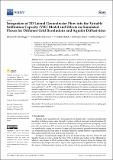Files in this item
Integration of 2D lateral groundwater flow into the variable infiltration capacity (VIC) model and effects on simulated fluxes for different grid resolutions and aquifer diffusivities
Item metadata
| dc.contributor.author | Scheidegger, Johanna M. | |
| dc.contributor.author | Jackson, Christopher R. | |
| dc.contributor.author | Muddu, Sekhar | |
| dc.contributor.author | Tomer, Sat Kumar | |
| dc.contributor.author | Filgueira, Rosa | |
| dc.date.accessioned | 2022-02-10T16:30:08Z | |
| dc.date.available | 2022-02-10T16:30:08Z | |
| dc.date.issued | 2021-03-01 | |
| dc.identifier | 277806942 | |
| dc.identifier | 0145f7d1-02bf-459a-97bb-154b4bae38f4 | |
| dc.identifier | 85102661633 | |
| dc.identifier.citation | Scheidegger , J M , Jackson , C R , Muddu , S , Tomer , S K & Filgueira , R 2021 , ' Integration of 2D lateral groundwater flow into the variable infiltration capacity (VIC) model and effects on simulated fluxes for different grid resolutions and aquifer diffusivities ' , Water , vol. 13 , no. 5 , 663 . https://doi.org/10.3390/w13050663 | en |
| dc.identifier.issn | 2073-4441 | |
| dc.identifier.other | Bibtex: ffab7e883f69448c9c73e13fbbcf1cad | |
| dc.identifier.uri | https://hdl.handle.net/10023/24849 | |
| dc.description | Funding: The authors would like to acknowledge the support of the UK Natural Environment Research Council and Indian Ministry of Earth Science Newton Bhabha joint-funded project "Coupled Human and Natural Systems Environment (CHANSE)" (NERC grant NE/N01670X/1; MoES/NERC/16/02/10 PC-II). | en |
| dc.description.abstract | Better representations of groundwater processes need to be incorporated into large-scale hydrological models to improve simulations of regional- to global-scale hydrology and climate, as well as understanding of feedbacks between the human and natural systems. We incorporated a 2D groundwater flow model into the variable infiltration capacity (VIC) hydrological model code to address its lack of a lateral groundwater flow component. The water table was coupled with the variably saturated VIC soil column allowing bi-directional exchange of water between the aquifer and the soil. We then investigated how variations in aquifer properties and grid resolution affect modelled evapotranspiration (ET), runoff and groundwater recharge. We simulated nine idealised, homogenous aquifers with different combinations of transmissivity, storage coefficient, and three grid resolutions. The magnitude of cell ET, runoff, and recharge significantly depends on water table depth. In turn, the distribution of water table depths varied significantly as grid resolution increased from 1° to 0.05° for the medium and high transmissivity systems, resulting in changes of model-average fluxes of up to 12.3% of mean rainfall. For the low transmissivity aquifer, increasing the grid resolution has a minimal effect as lateral groundwater flow is low, and the VIC grid cells behave as vertical columns. The inclusion of the 2D groundwater model in VIC will enable the future representation of irrigation from groundwater pumping, and the feedbacks between groundwater use and the hydrological cycle. | |
| dc.format.extent | 24 | |
| dc.format.extent | 4595572 | |
| dc.language.iso | eng | |
| dc.relation.ispartof | Water | en |
| dc.subject | Aquifer diffusivity | en |
| dc.subject | Grid resolution | en |
| dc.subject | Groundwater model | en |
| dc.subject | Soil moisture-groundwater coupling | en |
| dc.subject | VIC hydrological model | en |
| dc.subject | GB Physical geography | en |
| dc.subject | GE Environmental Sciences | en |
| dc.subject | QA75 Electronic computers. Computer science | en |
| dc.subject | QE Geology | en |
| dc.subject | DAS | en |
| dc.subject.lcc | GB | en |
| dc.subject.lcc | GE | en |
| dc.subject.lcc | QA75 | en |
| dc.subject.lcc | QE | en |
| dc.title | Integration of 2D lateral groundwater flow into the variable infiltration capacity (VIC) model and effects on simulated fluxes for different grid resolutions and aquifer diffusivities | en |
| dc.type | Journal article | en |
| dc.contributor.institution | University of St Andrews. School of Computer Science | en |
| dc.identifier.doi | 10.3390/w13050663 | |
| dc.description.status | Peer reviewed | en |
This item appears in the following Collection(s)
Items in the St Andrews Research Repository are protected by copyright, with all rights reserved, unless otherwise indicated.

